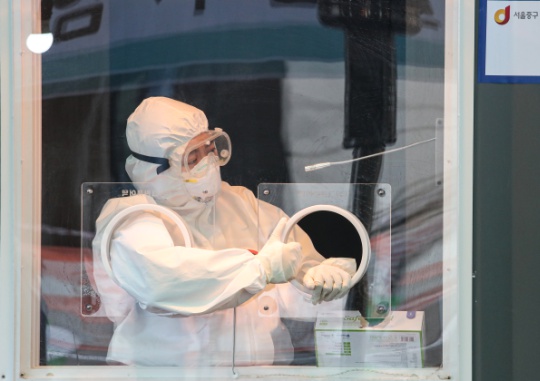COVID-19 Contagion Through Individual Contact Increased 30% in Two Months: Government Expected to Extend Ban on Gatherings of Five or More People
이 글자크기로 변경됩니다.
(예시) 가장 빠른 뉴스가 있고 다양한 정보, 쌍방향 소통이 숨쉬는 다음뉴스를 만나보세요. 다음뉴스는 국내외 주요이슈와 실시간 속보, 문화생활 및 다양한 분야의 뉴스를 입체적으로 전달하고 있습니다.
[경향신문]

The government is expected to adjust the physical (social) distancing measure on January 16, but the ban on private gatherings of five or more people is expected to be maintained. Health authorities believe a certain level of distancing has to be maintained, because individual contacts were the main route of contagion in the third wave of the novel coronavirus.
According to the “Contagion Routes in the Past Two Weeks” released by the Central Disease Control Headquarters on January 14, 40.7% of COVID-19 cases were transmitted through personal contact with a previously confirmed patient, such as family, acquaintance, and colleagues at work. In October 2020, before the third wave, cases through individual contact only accounted for 12.4% of the cases, but that rate has increased by nearly 30% in just two months. Meanwhile, clusters of transmission in public facilities dropped from 55.6% to 21.8%. Unlike the first two waves of the virus, where massive clusters of transmission accounted for the majority of cases, the third wave showed that contagion occurred sporadically in our daily lives.
Authorities are expected to enforce a new level of distancing on January 18, but many believe they will maintain the current ban on private gatherings of five or more people. Health authorities believe the ban on private gatherings has played a major role in curbing the latest wave of the virus. Kwon Joon-wook, second deputy director of the Disease Control Headquarters said, “We were able to decrease the number of new COVID-19 cases without tightening distancing to level 3 by banning private gatherings of five or more people,” and explained, “If we ease the distancing, there always exists the possibility of another wave of the virus.” Kwon also said, “We have the lunar New Year holiday coming up when travel is expected to increase. And we also have to prepare for stable vaccination in February. So we need to maintain a certain level of distancing.”
The Disease Control Headquarters announced that as of midnight this day, authorities confirmed 524 new cases of COVID-19. The number of patients in connection to the BTJ Center for All Nations in Sangju, Gyeongsangbuk-do increased to 713. The health authorities believe that more than 1,300 people among the 3,000 that visited the center have yet to be tested.
People who tested COVID-19-positive claimed to have suffered from side-effects, such as hair loss, fatigue, and weaker lung functions three months after recovery and also complained of other symptoms as time passed.
According to the interim result of a study on the clinical side effects of COVID-19 released by the Central Disease Control Headquarters this day, people suffered from hair loss and shortness of breath when exercising three months after recovery and a relatively large number of people suffered from fatigue six months after recovery. Among the patients who experienced weaker pulmonary functions, some ended up with pulmonary fibrosis six months after recovery. The latest study was conducted by the Korea National Institute of Health and the National Medical Center, and researchers recorded the status of forty adult patients every three months.
Copyright © 경향신문. 무단전재 및 재배포 금지.
- [단독]대통령실 옆 예식장, 경호·보안 이유 옥외주차장 일방 폐쇄···예비 부부들 ‘황당’
- 김건희 여사의 화려한 부활 [김민아 칼럼]
- 유영재, 선우은숙 언니 강제추행 혐의로 피소···“피해사실 알고 혼절”
- 대통령이 유도한 거절? 한동훈의 헤어질 결심?…‘한 전 위원장, 대통령 오찬 거절’ 해석 분분
- 민주당 친명 의원들 ‘주호영 총리설’에 호평···박영선엔 “영 아냐”
- ‘대학생 무상 등록금’, 전국 지자체 확산…“포퓰리즘 넘어 국가 차원 논의돼야”
- “불법 웹툰 안 봤다니까요” 들려온 이 말 의심한 시민…7000만원 피해 막았다
- 현대차, 차량 내부 20℃ 이상 낮춰주는 틴팅필름 개발…‘뙤약볕’ 파키스탄서 실증
- “우린 무능한 조폭, 저들은 유능한 양아치”···국민의힘 낙선자 등 ‘세력화’
- 어린이집 교사에 ‘인분 기저귀’ 던진 학부모…징역형 집행유예